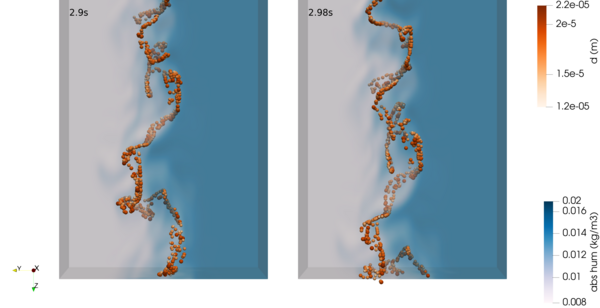Project for a better understanding of the mixing process of cloudy and cloud-free air masses
Clouds and the realistic consideration of their feedbacks remain one of the major challenges in the prediction of future climate1. Climate models are not capable to resolve relevant small-scale cloud processes, due to their coarse resolution. Unresolved processes are represented in terms of statistical formulations - parameterisations - that are inherently uncertain; this is particularly true if the underlying processes are non-linear and if they are poorly understood. One of the key small-scale processes that necessarily require parameterisation is the turbulent mixing of cloudy and cloud-free air, i.e. entrainment and detrainment (in the following simplified as entrainment), which describe the in-mixing of ambient air into the cloud and the mixing of cloudy air into the environment surrounding the cloud, respectively (see centre of Fig. 1). Entrainment changes cloud particle properties such as number concentrations and sizes, which also modifies the radiative properties of the cloud, and is responsible for the depletion of cloud water content, along with precipitation. It has thus important implications for cloud lifetime. Indeed, the mixing processes (including entrainment) and their treatment in the numerical models have been found to be responsible for much of the large spread found in climate sensitivity estimates. No reliable formulation exists to date that allows understanding and describing entrainment in terms of cloud- and environmental physical quantities ("the entrainment puzzle"). This is despite the fact that a wide variety of entrainment parameterisations exists. However, their dependencies on meteorological parameters remain controversial, which highlights that the entrainment process itself is not well understood.
The project, which receives funding from the European Union’s Horizon 2020 research and innovation programme as an Individual Fellowship under the Marie Skłodowska-Curie grant agreement number 835305, comprises three pillars:
Workpackage 1 - Identification
The turbulent wind tunnel LACIS-T will be employed using conditions as observed in real clouds during the "Azores stratoCumulus measurements Of Radiation, turbulEnce and aeroSols" (ACORES) field campaign. An international research team led by TROPOS had investigated clouds around the archipelago of the Azores in the North Atlantic, in July 2017. Parts of the atmospheric measurements were performed by the helicopter borne measuring platform ACTOS. The specific variation of single meteorological parameters in the wind tunnel experiments will help to identify those parameters that have the largest impact on entrainment.
Work Package 2 - Upscaling
The experiments will be accompanied by computational fluid dynamics CFD) simulations. On the one hand side, these simulations will be verified by the point measurements in LACIS-T, on the other side, they deliver the full 3d fields in the whole wind tunnel volume. Based on the measurements and with the help of the simulations, a new physical calculation for entrainment shall be established. This parameterisation will be upscaled from the mm-scale of the CFD simulations to 10m-scales as used in Large Eddy Simulations (LES) in the next step.
Work Package 3 - Verification
The new entrainment calculation scheme shall be implemented into the atmospheric forecast model ICON, which e.g. is used for weather predictions by the German Weather Service. ICON will be used in its LES configuration to simulate those case studies from the ACORES measurements which have also been used to determine the conditions for the wind tunnel measurement set up.
Training: As the Marie Skłodowska-Curie Actions aim at the further qualification of the participants, this project involves a work package with the training objective. This comprises workshops and seminars focussing on various soft skills and also participation in the Leibniz Mentoring Programme.


